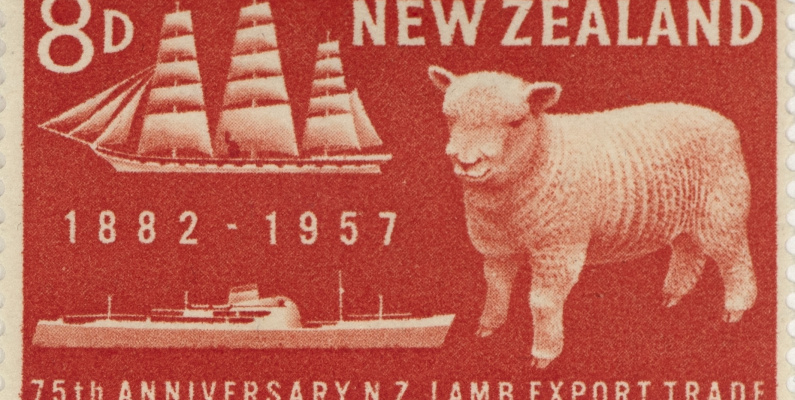
To celebrate the anniversary of the SS Dunedin's journey to England, one of our Honorary Curators, Dr Melville Carr, is here to tell us about New Zealand stamps featuring sheep and frozen lamb.
15 February, 1882 was a red-letter day of momentous importance for the sheep farmers and, in fact, for all of New Zealand. It was on this day that the SS Dunedin, an Albion Shipping Company sailing vessel of 1320 tonnes displacement, carrying 234 tonnes of frozen lamb left Port Chalmers destined for London, England. This enterprise was commemorated in the 6d Centennial stamp of 1940 with a depiction of the ship and its route across the South Pacific Ocean to Cape Horn and north in the Atlantic Ocean to Britain; the image of this is below

Image: 6d Centennial stamp showing the SS Dunedin and its route from Port Chalmers to London, 1940
The story behind this incredible event began in the 1860s when the price of wool was falling and the utilisation of sheep meat was confined to the extremely small local market. Canned meat was a possibility for export to the huge market in Britain but ventures failed for a variety of reasons. Commercial refrigeration was developed in the 1870s and, in 1879, a small shipment of frozen meat was successfully exported to London from Australia. William Davidson, a Scotsman, arrived in New Zealand in 1865 where he worked as a shepherd in Canterbury and later became the General Manager of The New Zealand and Australia Land Company. He organised the fitting out of the SS Dunedin with insulated meat chambers and refrigeration machinery. Meanwhile, Thomas Brydone organised the preparation of the sheep for the first shipment at Totara Estate, 10 km south of Oamaru.
The first attempt was disastrous when engine failure necessitated the sale of 641 carcasses packed in icy chambers to be sold locally. But later 240 carcasses were packed in ice and sent to Dunedin each morning by train until the 4311 carcasses of mutton, 598 of lamb, 22 of pork, and 2226 sheep’ s tongues were loaded. SS Dunedin sailed from Port Chalmers on 15 February, 1882 and arrived in London 98 days later with the cargo in good condition and were all sold in the Smithfield Market within a fortnight. During the voyage there was some concern that sparks from the boiler may set fire to the sails!
In the ensuing years, there were huge advances in technology from sailing ships to steamships and then motorised vessels using fuel oil and the development of better and more efficient refrigeration equipment. At the same time, the demand for frozen meat in the Northern Hemisphere was increasing rapidly. Two postage stamps reflect these changes. The cargo ship Tamaroa is shown loading butter and meat in the 6d Chamber of Commerce stamp, and the 5d Peace stamp of 1946 depicts the Dominion Monarch, a passenger liner used as a troop ship during World War II, which also carried frozen meat to Great Britain (pictured below).

Images: 6d Chamber of Commerce stamp showing the cargo ship Tamaroa, 1936 and 5d Peace stamp depicting the Dominion Monarch, 1946
On 15 February, 1957, the 75th anniversary of the first shipment of frozen meat was commemorated with two postage stamps; 4d showing a lamb straddling a map of NZ, and 8d with a lamb and the SS Dunedin together with MV Port Brisbane; see the image below. Both the refrigeration technology and the type of ship had undergone immense changes between 1882 and 1957. The Port Brisbane, of 11 942 tonnes displacement, carried 5700 tonnes of frozen meat and had no sails.

Images: 4d stamp marking the 75th anniversary of the New Zealand frozen meat export trade, 1957, 8d stamp marking the 75th anniversary of the New Zealand frozen meat export trade, 1957
In February, 1982, the centenary of the frozen meat export industry was commemorated on a 30c stamp that showed the New Zealand Pacific container ship, of 43 704 tonnes displacement and capable of carrying 11 838 tonnes of frozen meat, 50 times more than SS Dunedin, pictured below. The current container ships have increased in size and the number of sheep in New Zealand is declining.

Image: 30c stamp commemorating the centenary of the frozen meat export industry, 1982
And, so ends the discussion of sheep on New Zealand postage stamps.
